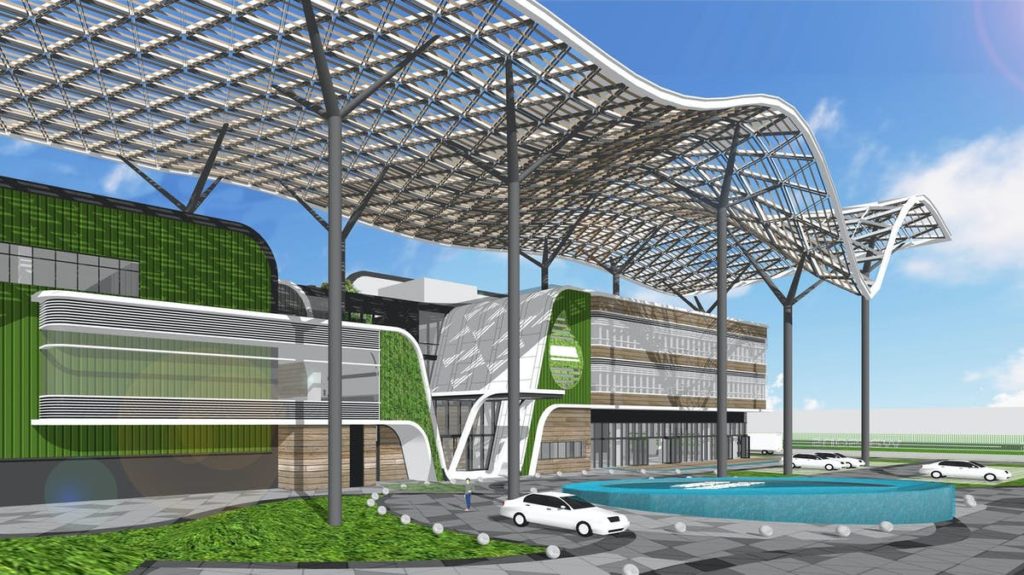[ad_1]
New architectural design requirements under carbon neutrality goals
With rapid urban and economic development, energy consumption is increasingly posing threats to the natural environment while the quantity and intensity of energy use in buildings are growing. As the Paris Agreement is leading a global shift towards a Greener economy and sets out the minimum actions required to protect our planet, it is having a huge impact on worldwide political and economic activities. With China’s pledge to peak its carbon dioxide (CO2) emissions by 2030 and achieve carbon neutrality by 2060, carbon has now officially become the world’s environmental index. According to the China Building Energy Consumption Report published by China Association of Building Energy Efficiency in 2020, the building sector will be contributing 51.3 per cent of the carbon emissions from industry, building and transportation—the three main sectors in need of Green reform. Therefore, the design, operation, management and use of buildings will directly affect the effectiveness of carbon neutrality efforts in cities. Putting emphasis on architectural design to save energy, cut emissions and create carbon sinks has also become one of the preferred strategies for tackling climate change and meeting carbon targets.
LWK + PARTNERS believes that zero energy buildings are a key means of achieving China’s carbon goals and therefore a future market trend. They require a technical approach that features ‘Passive first, active enhancement, maximise renewable energy use, and human-oriented post-occupancy evaluation’. It aims to ensure a healthy building interiors, functionality and efficiency, formulate carbon-neutral design features, create new low-energy building typologies, improve energy efficiency and smart integration, promote passive design and renewable energy use, and foster ever-better energy saving performance in buildings.
This article investigates the aspects of designing zero energy buildings with a case study in China, contributed by Professor Stephen Lau, Design Research Director leading the Design Research Unit at LWK + PARTNERS.
Applications of low-carbon building innovations
The Carbon-Neutral Building Design project in Guangdong, China is close to transport infrastructure and consists of five large buildings, taking up a site of 80,000 square metres with a maximum building density of 48,000 square metres. During the early design stage, a strength and weakness analysis was conducted on existing solutions, so it was decided to integrate the project with low-carbon design. LWK + PARTNERS works closely with the client to evaluate traditional methods and develop better design frameworks. In response to carbon neutrality objectives, it involves a close review of the site, building envelope and roof for informing low impact development, and low-energy integrated design based on ‘passive first’ and ‘maximise renewable energy’ principles. Below are the low-carbon technologies applied by the team:
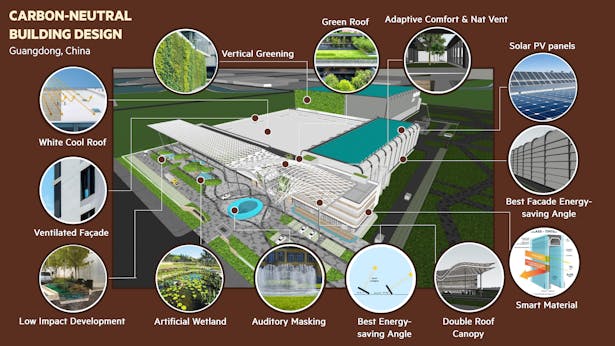 Low-carbon features at Carbon-Neutral Building Design, Guangdong, China
Low-carbon features at Carbon-Neutral Building Design, Guangdong, China
Building envelope design
The Carbon-Neutral Building Design project is classified under the ‘hot summer and warm winter zone B’ in the thermal zoning of Chinese buildings, which emphasises natural ventilation, heat insulation and solar shading. According to China’s General Principles of Green Factory Assessment and Assessment Standard for Green Buildings, factories are recommended to save materials, energy, water and land, minimise harm and use renewable energy through the choice of materials, structures and lightings. The thermal insulation performance of the roofs and external walls should also meet requirements stated in the national standard of GB 50176 Thermal Design Code for Civil Buildings. This is why, in addition to maintaining a standard level of insulation of the structures, like focusing on insulating the western side of the building, using materials with lower heat transfer coefficients and applying light-coloured finishes and insulative paints, LWK + PARTNERS also proposes five key strategies for designing the building envelope:
Strategy 1: Orient the building to receive more solar radiation
Strategy 2: Adopt uneven façades to reduce transfer of heat
Strategy 3: Use ventilated façades to raise energy efficiency
Strategy 4: Adopt intelligent materials to optimise energy use and assist with energy management
Strategy 5: Apply passive design features to save energy
In line with Strategy 2, the Carbon-Neutral Building Design project is slightly slanted and adopts uneven façades. In order to raise energy efficiency and cut CO2 emission. For example, on the summer solstice, for the best results in cooling and smoke extraction, horizontal devices along the façade can be adjusted at 28° 27′, exactly the same as the respective angle of sun. This setting is recommended to last till 5pm on the day. Under Strategy 3, ventilated façade are designed to form double-skin curtain walls through its supporting structures, creating a stack effect to activate convective air circulation and improve the acoustic and thermal insulation of the building, thus increasing energy efficiency.
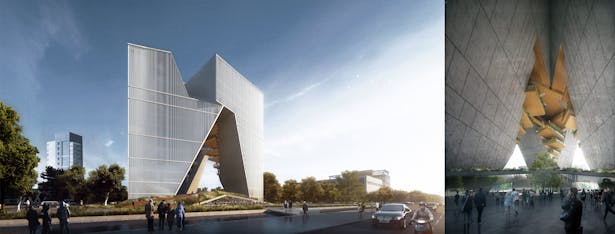 Building form as passive design tool: A central negative space promotes a microclimate in this office building competition proposal by LWK + PARTNERS, allowing natural light and wind through its core where shared facilities and communal areas are centralised, with offices allocated on the outer range.
Building form as passive design tool: A central negative space promotes a microclimate in this office building competition proposal by LWK + PARTNERS, allowing natural light and wind through its core where shared facilities and communal areas are centralised, with offices allocated on the outer range.
Canopy design
Climate-resilient design as a key tool of passive design needs to reach a higher level to bring down energy demand for heating and air-conditioning in buildings, while giving architects and designers greater opportunities to implement design objectives. Based on climate analysis, the most appropriate passive design strategies are shading, indoor heat gain, natural ventilation for cooling, dehumidification and optimisation of air-conditioning efficiency. These strategies are effective in improving energy efficiency and indoor comfort. The following example, again with the Carbon-Neutral Building Design project, shows how canopy design can facilitate shading.
The project’s canopies are designed in response to the angle of the sun’s shadow. Considering the canopy’s position in relation to the façade, two types of canopies are adopted. Type 1 canopies are designed to shield building walls, which means they fend off direct exposure to the sun during spring, summer and autumn to minimise heating/cooling loads of building surfaces. Type 2 refers to canopies over entrances and glass curtain walls. These are spots where people gather, so the main consideration is to bring sunlight into the interiors during winter for lighting and warmth. Combined with calculations of the canopy dimensions and height of the building’s southern façade, Type 1 features louvres for shielding radiation when the angle of the sun exceeds 13°. From site analysis regarding sun paths, aluminium louvres can provide good shading from noon to around 5pm. For the canopies to be excluded from plot ratio calculations, they must be at least 80 per cent hollow while the slanting of aluminium louvres must be less than 11.5°. To maximise slanting for shading, the canopy itself must be slanted at 11.5°.
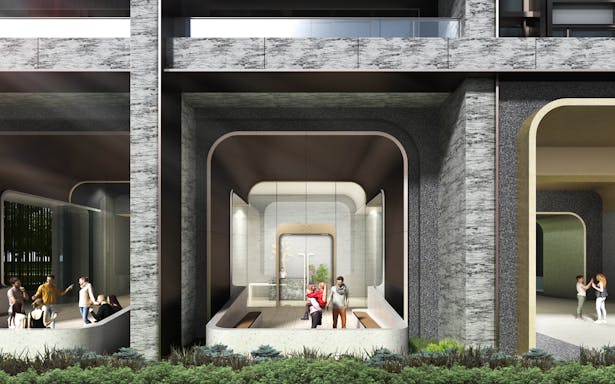 LWK + PARTNERS often integrates well-ventilated gathering spaces in its residential projects such as Green Shore Residence Phase II in Guangzhou, China.
LWK + PARTNERS often integrates well-ventilated gathering spaces in its residential projects such as Green Shore Residence Phase II in Guangzhou, China.
Besides, LWK + PARTNERS proposes to add a second layer of canopy above the first, to further shade the roof while squeezing out the heat between the first and second canopy layers and the roof, helping reduce the cooling load on the building space. The double roof structure works with an air chamber to achieve separation, while the layer in between provides additional architectural lighting. If the layers have the same rate of hollowness, this kind of design also enlarges the shaded area, creating a sheltered outdoor living space.
Aquatic design and landscape system for low impact development
In terms of climate, the Carbon-Neutral Building Design project sits on subtropical land susceptible to monsoons, humid weathers and generous rain. To reduce water consumption, which indirectly increase carbon emissions, the project contains features that collect rainwater from different sources including the roof, surface run-off and vegetation catchment. Water from initial disposal tends to be cleaner and can be reused for miscellaneous purposes after a simple treatment. It is estimated that reusing rainwater alone can supply 100 per cent of the miscellaneous water use for this project. The area’s water supply mainly serves office buildings, factories, plant watering and road sprinkling.
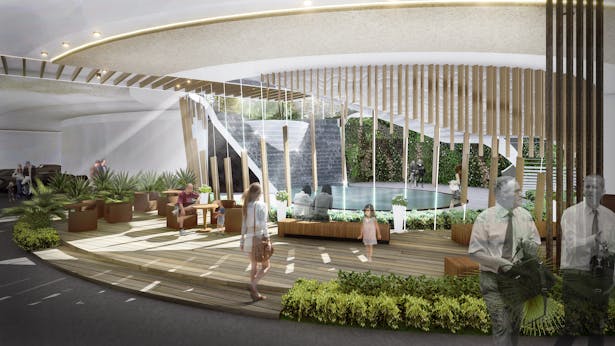 To reduce air-conditioning demands, underground spaces should be designed to take in maximum sunlight and natural ventilation, illustrated by the landscape design of Tianheng‧Bayview, Zhuhai, China.
To reduce air-conditioning demands, underground spaces should be designed to take in maximum sunlight and natural ventilation, illustrated by the landscape design of Tianheng‧Bayview, Zhuhai, China.
Referencing local low-impact development (LID) requirements, the project also includes a range of other green features. These are often landscape features based on blue-green design principles that aim to promote carbon sinks, water recycling, sponge city concepts, artificial wetland landscape and water savings. A LID strategy is mainly proposed for the southern side of the site. The first strategy addresses the large volume of rainwater runoff and potential overflow from the project site. This water can be used for a storm water wetland, retained through physical devices, aquatic plants and microorganisms. The wetland can both be an ecological landscape as well as a public space. The second strategy addresses the body of underground, still water. Multiple layers of vegetation is used to build a revetment, with permeable paving, rain gardens and other measures to create artificial wetlands. This way, rainwater undergoes infiltration, storage, regulation and purification, simulating the nature environment. The stepped arrangement of these semi-natural structures not only meets LID objectives, but also serves a variety of other functional needs.
 LWK + PARTNERS’ design proposal for an office building competition provides porous layers of experiential, landscaped spaces around the airy atrium.
LWK + PARTNERS’ design proposal for an office building competition provides porous layers of experiential, landscaped spaces around the airy atrium.
Photovoltaic (PV) system
Maximising renewable energy means to offset and balance a building’s energy consumption through exploitation of renewable energy. In the Carbon-Neutral Building Design project, LWK + PARTNERS makes great use of the building skin and tap nearby sources to generate renewable energy. Again the local climate and angle of the sun were studied. PV simulation software is used to analyse rooftop radiation, the optimal tilt angle of the PV panels and the distance between the panels to derive the optimal amount of solar power to be generated annually, thereby estimating the reduction in electricity consumption of the building. This is then combined with electricity emission factors to calculate how much electricity-related CO2 emissions are saved after the use of PV panels.
Information on electricity emission factors is obtained from 2010 Average CO2 Emission Factors of China’s Regional and Provincial Power Grids published by the Department of Climate Change of the National Development and Reform Commission of China on 11 October 2013, on the China Climate Change Information website. The preset value of the electricity emission factor is 6.379 tonnes of CO2 per million kWh, according to the Guangdong Enterprise (Unit) Carbon Dioxide Emission Information Reporting Guide (Revised 2020). By multiplying the amount of PV-generated power and the electricity emission factor, the team gets the amount of carbon emissions saved. In the Carbon-Neutral Building Design project, PV panels help save approximately 89.3 tonnes of CO2 emissions per year and will reduce 1,339.6 tonnes of CO2 emissions over its entire life cycle, assumed to be 15 years.
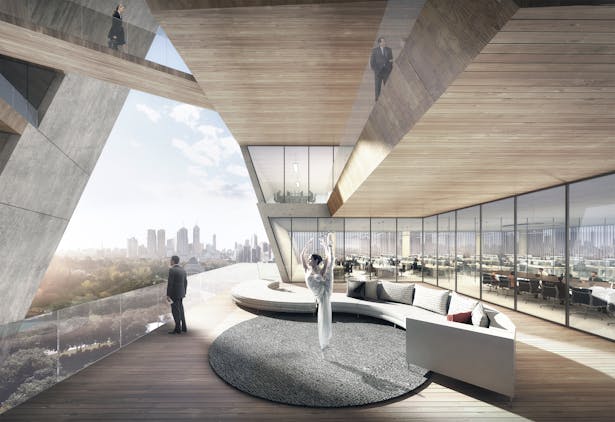 Shading over social spaces provides an open-air experience, illustrated by a competition proposal of an office building.
Shading over social spaces provides an open-air experience, illustrated by a competition proposal of an office building.
Conclusion and prospects
Overall, all buildings take more or less the same technical approaches for saving energy and cutting emissions. In 2019, China authorities launched the Technical Standard for Nearly Zero Energy Building. For the Carbon-Neutral Building Design project illustrated above, the design strategies mainly centre on ‘passive first’ and ‘maximise renewable energy use’ principles. To supplement the three approaches set out by this standard, LWK + PARTNERS proposes a fourth element, which is ‘human-oriented post-occupancy evaluation’. This closes the loop by taking into account the experience of real users to inform future design and further enhance a building’s performance in carbon reduction. LWK + PARTNERS will apply this to the Carbon-Neutral Building Design project throughout the whole building life cycle from design to operations, management and use, tracking post-occupancy data through digital platforms. The practice believes that closely monitoring post-occupancy data has an informative effect on carbon emission control, the making of user experience as well as building cost control. In the long term, such data is also key to achieving carbon reduction goals.
Passive design is an effective tool to enhance building form and spatial design while upgrading the energy system. At the same time, low-carbon innovations are vital for integrating renewable energy use in architectural design and capturing human factors through user behaviour. As the threat of climate change looms large, architects and engineers have a leading role to play in China’s carbon reduction goals and our future urban development on the whole.
*The article first published on FuturArc
[ad_2]
Source link
